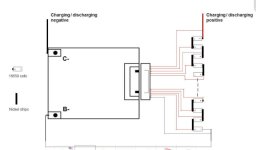I replaced my old fried BMS and then took the bike out for a 5 mile ride and the battery (13s5p all Samsung 35E cells) was working great. Plenty of power (up to around 1600 watts max) and voltage was good. I turned off the display and let it sit for about 15 minutes. When I tried to turn it back on, the display only lit for a fraction of a second and then went dead. The battery also would no longer take a charge. After taking the battery apart and checking that all individual cell groups had good voltage (4.0 to 4.1), and the output on the BMS (C-) was the same as the battery input (B-) (53v) with no load. As soon as any load was added the BMS output drops to zero.
I then pulled off the BMS sensing wires connector and re-seated it. The battery once again will take a charge and also supply load power. Although I have not put the battery back together yet for a more though test, I believe the battery is now working properly again. I am now wondering if once the BMS shuts down for any reason, that momentarily disconnecting the sensing wire connector is the way to reset the BMS. What do you think? Is there a problem with the BMS, or with a weak battery group (even though they all have normal voltage) or the connector for the sensing wires, or one of the sensing wires intermittent open or maybe the battery is just out of balance? Any suggestions on a test that will reveal the issue?
I then pulled off the BMS sensing wires connector and re-seated it. The battery once again will take a charge and also supply load power. Although I have not put the battery back together yet for a more though test, I believe the battery is now working properly again. I am now wondering if once the BMS shuts down for any reason, that momentarily disconnecting the sensing wire connector is the way to reset the BMS. What do you think? Is there a problem with the BMS, or with a weak battery group (even though they all have normal voltage) or the connector for the sensing wires, or one of the sensing wires intermittent open or maybe the battery is just out of balance? Any suggestions on a test that will reveal the issue?


